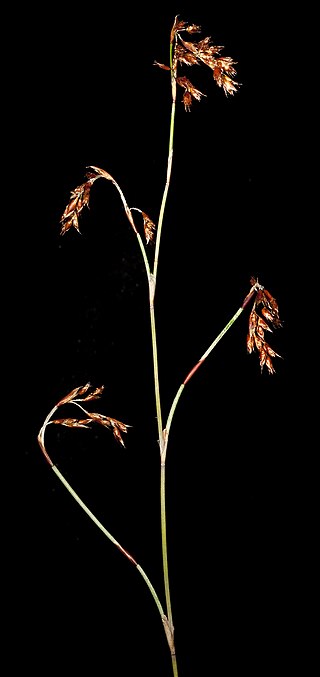
The Restionaceae, also called restiads and restios, are a family of flowering plants native to the Southern Hemisphere; they vary from a few centimeters to 3 meters in height. Following the APG IV (2016): the family now includes the former families Anarthriaceae, Centrolepidaceae and Lyginiaceae, and as such includes 51 genera with 572 known species. Based on evidence from fossil pollen, the Restionaceae likely originated more than 65 million years ago during the Late Cretaceous period, when the southern continents were still part of Gondwana.

Apodasmia is a group of plants in the Restionaceae described as a genus in 1998. It is native to Australia, New Zealand, and Chile.
Hypolaena is a plant genus in the family Restionaceae, described as a genus in 1810. The entire genus is endemic to Australia.

Alexgeorgea is a genus of three plant species found in Western Australia belonging to the family Restionaceae named in honour of the botanist Alex George in 1976. The flowers of the female and large nut-like fruit are completely underground except for the stigmas, which extend out of the ground as 3 purple or red threads.

Leptocarpus is a genus of dioeceous rush-like perennial plants described as a genus in 1810.

Chaetanthus is a group of plants in the Restionaceae described as a genus in 1810. The entire genus is endemic to the southern part of Western Australia.

Desmocladus is a genus of herbs in the family Restionaceae, all species of which are endemic to Australia, and found in Western Australia and South Australia. In this genus, the stems are the principal photosynthesizers.

Chaetanthus aristatus is a species of rush. It is found in Western Australia.

Chordifex microdon is a rush species of the genus Chordifex in the family Restionaceae, native to Western Australia.
Leptocarpus laxus is a rush species of the genus Leptocarpus in the family Restionaceae. It is endemic to the south-west of Western Australia.

Sporadanthus rivularis is a sedge-like herb in the Restionaceae family, native to Western Australia. It is a spreading perennial growing from rhizomes to heights of from 1 to 1.2 m, on black sands and clay along creek edges. It is a dioecious species.
Tyrbastes is a genus of flowering plants belonging to the family Restionaceae.

Tremulina is a genus of flowering plants belonging to the family Restionaceae. The genus was first described in 1998 by Barbara Briggs & Lawrie Johnson. The type species is Tremulina tremula.
Catacolea is a genus of flowering plants belonging to the family Restionaceae.
Cytogonidium is a genus of flowering plants belonging to the family Restionaceae.
Melanostachya is a monotypic genus of flowering plants belonging to the family Restionaceae. The only species is Melanostachya ustulata.
Platychorda is a genus of flowering plants belonging to the family Restionaceae.

Tremulina tremula is a plant in the Restionaceae family, found in the south-west of Western Australia.

Leptocarpus coangustatus is a species of plant in the Restionaceae (rush) family, endemic to Western Australia.

Leptocarpus denmarkicus is a species of plant in the Restionaceae (rush) family, endemic to Western Australia.











